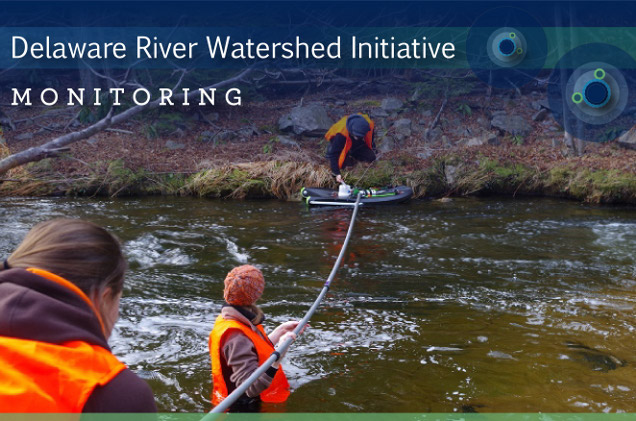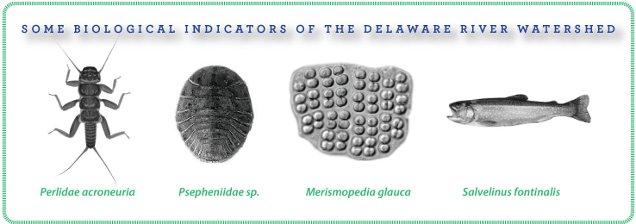
The DRWI is about measuring impact and achieving results. How do we measure impact, specifically as it relates to water quality and ecosystem health? The answer: strategically designed monitoring.
Monitoring streams’ health using certain species as biological indicators has a long history as an effective approach to measuring human-derived stressors and environmental changes. Dr. Ruth Patrick, the Patrick Center’s namesake, pioneered the use of bioindicators more than 60 years ago, and the Center has been a leader in stream monitoring ever since.
Fish, macroinvertebrates (“bugs”), algae, and salamander communities often exhibit different responses to stressors. If researchers detect certain algae and bacteria tolerant to pollutants, they can conclude that pollution is likely present. Other organisms, like mayflies and many fish species, are intolerant of pollution. Their presence suggests a strong and healthy waterway, while their absence suggests an environmental imbalance. Many amphibians are very sensitive to environmental changes, and so are also examined to judge the health of ecosystems.

Biological samples give more information on habitat suitability over the long-term than one-time chemical samples. Water chemistry and stream geomorphology measures, which are also being taken, give additional information about ecological condition that bioindicators can’t provide.
Sampling is being conducted at more than 200 sites across the basin using standardized protocols developed by the Academy. All monitoring data will eventually be combined into a single database, enabling basin-wide analyses that have never before been possible.
The DRWI monitoring effort’s design is described in the Coordinated Monitoring Plan for the Subwatershed Clusters, and the standardized protocols are detailed in the Quality Assurance Project Plan.
Impact Evaluation

We may think that project activities have had their intended impact, but how can we know for sure? Maybe water quality would have stayed high at an intact site without any additional protection, and maybe water quality would have improved at an impaired site due to factors other than restoration activities.
Teasing out whether DRWI activities are making a difference requires more than just monitoring at sites where those activities are taking place. It also requires monitoring at paired “control” sites where conditions are identical—or as close to identical as possible—except for the absence of project activities.
The use of paired controls and “treatments” is standard practice in medical trials, but it’s rare for evaluating the impact of conservation activities. Scientists can’t control conditions outside like they can in a laboratory, so finding paired sites is notoriously difficult. But Academy scientists are rising to the challenge, using computer-based modelling to identify the best paired sites and implementing monitoring at them. This commitment to rigorous, science-based impact evaluation is a distinguishing feature of the DRWI.
Project Science Director Dr. Stefanie Kroll answers the question, Why are we doing so much monitoring?
At ANS we’re so excited to be in the swing of monitoring during another year of restoration, protection and research in the DRWI. Over the past 3 years we’ve been working closely with groups throughout the watershed on coordinating in-stream monitoring directed at measuring the effects of on-the-ground restoration and protection actions. Our monitoring partners work closely with the regional conservancies and non-profits that implement these actions aimed at managing agricultural and urban stormwater and protecting forested land. The monitoring groups have responded with a diverse set of solutions to collecting indicators of aquatic health. But sometimes people still wonder about the purpose of all this monitoring. Now that we are putting together site lists and preparing our field crews, we think it is a perfect time to get back to that critical question: Why are we doing so much monitoring?
When ANS, Stroud, and DRWI partner groups began to work together on monitoring plans during the implementation planning period in 2013, we reviewed the published literature on the effects of restoration and read hundreds of peer-reviewed articles and government reports on water quality and conservation actions. We were surprised to find that the National River Restoration Science Synthesis website, which held information on nationwide restoration work, had been shut down in 2012. Even so, while that resource was available there were very few studies describing ecosystem responses to agricultural BMPs (e.g., reductions in nutrients and sediments) and other restoration actions on the scale of a HUC12 subwatershed (approximately 50 mi2) or a larger HUC10 watershed (e.g. the Lehigh and Schuylkill Rivers).
We know that Best Management Practices (BMPs) for point and non-point source pollution controls have improved water quality over very large regions, such as the Mississippi and the Gulf of Mexico, the Puget Sound, and our immediate neighbor to the south, the Chesapeake Bay. When we move upstream on these larger rivers to see what BMPs worked, it’s really hard to see the big picture unless we focus on a smaller scale.
Restoration ecology is a young discipline, only 20 years old, and for those of us who studied it in school and grew with it in our careers, we’re still figuring out how best to implement it! We do know riparian buffers can intercept runoff and its components, and we have a good idea of the impacts that different agricultural BMPs have on nutrient and sediment inputs. We are still learning about which stormwater control measures have the greatest effect on water quality and quantity. But more importantly, there have been only a few studies looking at how aquatic ecosystems as a whole are improved by these measures. The few studies that do exist emphasize the need for collecting more data at more sites over a longer period of time. In addition, restoration ecologists know how to suggest BMP implementation to address certain sources of runoff but are missing information on the last step of the intervention: What does success look like in smaller streams and headwaters draining these lands? In other words, we know what to expect in theory but we don’t know if each project is accomplishing those goals at the scale of the headwater, the farm, the nearby receiving stream, or the subwatershed as a whole.
So why is it important that we carry out these ecosystem-based monitoring studies? Why can’t we just stick to monitoring for reductions in nutrients and sediments on the mainstem of a river after a restoration, and if nutrients and sediments go down, deem the endeavor a success? Why does it matter if biological indicators such as a healthy fish and aquatic insect community respond? Many of you know that we monitor the biota to understand year-round and year-to-year functioning of ecosystems. A recent visiting colleague, Marie Kurz, discussed her research in Germany, where they have found places with perfect water chemistry and habitat but impoverished biota. What does that mean? It means the stream may be physically intact, but it is not functioning in a healthy, natural way. It means that even though most aspects of habitat have been restored, the biota have not returned to perform their essential roles: nutrient assimilation through growth of plants and algae, detritus processing and consumption of primary producers by macroinvertebrates and fish, and the subsequent voyage up the food chain to support higher trophic levels, up to the top predators. A complex food chain is a sign that inputs into a stream are being processed and energy is transferring between biotic and abiotic sources, and this creates the healthy nutrient cycles we learned about in school.
Along with the Phase II Planning tool under development by Barry Evans and Scott Haag, I have put together a working group to define ecological targets of restoration and preservation (which we can collectively refer to as conservation). This group includes aquatic ecologists who work with specific organism groups, including fish, macroinvertebrates, diatoms, and bacteria. When I invited my colleagues, they were excited but acknowledged we have a big task ahead of us! To quote one member: “This sounds great, albeit really hard …We really don’t know how well restoration works because we’ve so little data to gauge how [ecological] metrics respond.”
Experts have called for better monitoring for restoration since 1999, but our work in the DRWI is the largest, most complete answer to that call. We are breaking ground on how to set ecological goals for our on-the-ground work. Furthermore, we are doing this because stable, healthy ecosystems are the only real evidence that the theories driving restoration goals are resulting in healthy, more stable, resilient, and natural ecosystems that can sustain themselves properly.
At ANS, we have also been writing a concept paper on our DRWI approach and the characteristics that make it unique for submission to a peer-reviewed journal. We believe we have the perfect template for monitoring restoration and preservation actions aimed at improving watershed health, and we want to share it with the larger scientific community, as well as practitioners and watershed associations outside of our region. Scientists here at ANS and our colleagues at public agencies (e.g., USEPA, NJDEP, PADEP, DNREC) and non-profit groups we meet are always excited to hear about the Academy’s role in the Delaware River Watershed Initiative and the collaborative work coordinated among so many groups.
Our colleagues are especially impressed when they see how many organizations and areas our integrated approach is reaching, using robust standards and protocols. The successful DRWI monitoring collaboration between ANS, Stroud Water Research Center, and both large and small environmental non-profit partners, is one of the unique aspects of our project.. Our basin-wide dataset, using multiple indicators across different sub-watersheds, trophic levels, and biomes is unique, specifically as it applies to identifying ecosystem changes over time due to conservation actions. So, when someone asks me “Why so much monitoring?” I tell them we are in the process of improving the health, functioning, and resilience of our streams, and without the monitoring we have no yardstick and won’t know how much of a difference it will make!